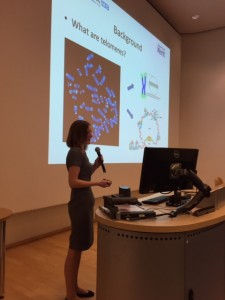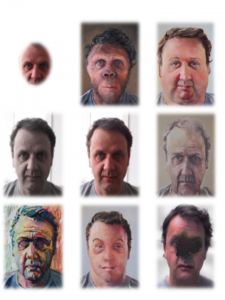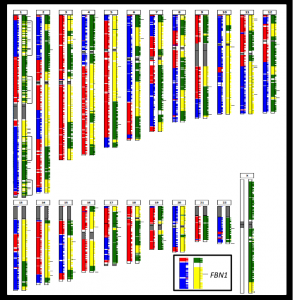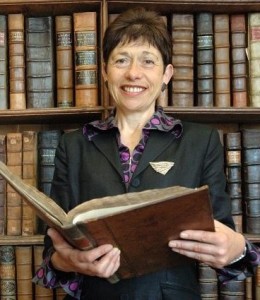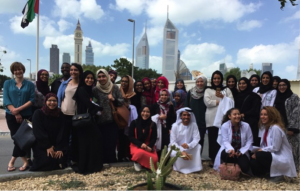Dr Kara Turner (Biosciences) gave the opening talk of the Neonatal Society meeting at Great Ormond Street hospital in March.
Category Archives: Uncategorized
Latest CISoR newsletter published!
The second CISoR newsletter has just been published detailing our first two events, our contributions to national news and debate as well as the latest in research and outreach.
This and the previous newsletter can be found by following this link….
http://www.kent.ac.uk/cisor/Newsletters.html
Your personal Genome in 25 self-portraits
Darren Griffin and award winning portrait artist Keith Robinson recently joined forces to initiate a project that combines genomics and portraiture. The project is ongoing and the idea is to represent each human chromosome 1-22, X, Y plus the mitochondrial DNA, each as a separate version of the same face. In this case the face is that of the artist Keith. Many aspects of genetics and genomics will be considered including disease, variation, evolution, behaviour, development and environmental interaction.
Darren said “the real challenge was, how do we represent a chromosome as a self portrait? There are issues of style of painting, manipulating the face, seeing a disease through the eyes of the sufferer and even visual puns. Basically we start the process by me coming up with ideas and doing a very crude version of the portrait using apps such as “Oldify” or “Fatify” – Keith then does a more professional version using image manipulation software ahead of working his magic by creating a portrait.”
The idea is to try and create a total of 25 portraits and Keith will be visually referencing art history and popular culture with some of them. The team (which also includes Keith’s brother Gary (Kent Innovation and Enterprise and the School of Biosciences)) will also try to raise science communication funds to see if they can complete the collection and enter some national exhibitions.
If all goes well then stage 2 will be to create a digital arts program that generates an individualized “25-image grid” reminiscent of an Andy Warhol piece based on Keith’s portraits of anyone that chooses it. This would be a personal “gift” item and we have already tried this out on one or two willing “victims.” The team plan to work with colleagues in Digital Arts to achieve this. If they can continue to get funding, the final stage will be to create interactive mirrors – a sort of digital version of the “curved mirrors” you see in fairgrounds. The concept would be that the viewer could go into a gallery and look into an iPad – their “reflection” would be one of these digital images in real time.
One aim of the project is to challenge notions of disease as compared to natural variation (often the two are not easily distinguished). What is “normality” and what is mutation? The project will also challenge the notion of disability (e.g. how would someone feel seeing themselves as portrayed as someone with Down Syndrome (how would someone with Down Syndrome feel?)) as well as bringing the concepts of genetics and genomics to the general public in an accessible way.
A snapshot of some of the work in progress. The top-left, middle-left and bottom-right panels represent disease and variation through the eyes of the beholder (chromosomes 1 (retinitis pigmentosa), 7 (blue yellow colour blindness) and mitochondrial DNA (optical neuropathy) respectively). The top-middle panel represents evolution (chromosome 2). The top-right panel represents genes on chromosome 3 that are related to fatness, the middle-right panel (chromosome 8) represents ageing, the bottom-left panel (chromosome 10) represents stress and the bottom-middle panel (chromosome 21) Down syndrome. The centre panel (chromosome 17) is left unaltered to represent cancer as this is something that affects the lives of everyone.
A surrogacy conundrum that didn’t need to be
Dr Kirsty Horsey of the Kent Law School comments on the recent case where a single man who had a child by surrogacy (where his mum was the surrogate) was allowed by the court to adopt the child, becoming its legal father: “A surrogacy conundrum that didn’t need to be” on the Bionews website, see link below…
Reproductive Fitness in Mauritius Parakeets
Universal genetic diagnosis for IVF
The Griffin lab in collaboration with the Bridge Centre (part of the London Women’s Clinic Group), the Universities of Cambridge and Oxford and the company Illumina Inc have taken a step closer to the full implementation of a universal test for the diagnosis of genetic disease in human embryos. The first paper (Natesan et al 2014) published in the Journal RBM Online described the clinical application of the approach (known as “Karyomapping”) for the detection of both gross genomic (chromosomal) abnormalities and the disease “Smith-Lemli-Opitz (SLO) syndrome.” SLO is a debilitating disease that affects many parts of the body e.g. a small head size, intellectual impairment, malformations of the heart, lungs, kidneys, gastrointestinal tract, and genitalia are also common. SLO infants typically also have a weak muscle tone, problems with feeding, slow growth, fused toes and extra fingers. Current diagnostic methods have the drawback of time and cost related concerns associated with tailoring a specific test for each couple and/or disorder. The family in question underwent IVF followed by Karyomapping, which was used to confirm “gold standard” approaches for the detection of genetic disorders.
Karyomapping, unlike the standard approaches performed alongside it, required no a priori test development. A singleton pregnancy and live birth, unaffected with SLO syndrome and with no chromosome abnormality arose. The study demonstrated that Karyomapping is potentially capable of detecting a wide spectrum of disorders. The second study (Thornhill et al. 2015) published in the Journal of Assisted Reproduction and Genetics established that Karyomapping could be used for the detection of Marfan Syndrome. This disease has far more variable features than SLO but can include enlargement of the aorta (which can cause a range of clinical problems and be life threatening) as well as problems with the connective tissue in the heart, lungs and skin. In this case, a couple, where the male partner was affected by Marfan syndrome underwent IVF and Karyomapping which, again, was used to confirm the gold-standard approaches in a clinical setting. A twin pregnancy ensued and neither children were affected with the disease – sadly however one of the babies died just after birth on an infection (which was unrelated to the procedure). The surviving twin however is fit and healthy. The manuscript features on the front page of the journal and was co-authored by University of Kent honorary staff Alan Handyside, Michael Summers and Alan Thornhill, recent PhD graduate Gary Harton and PhD student Christian Ottolini. Senior author on both papers Professor Darren Griffin said “I’m delighted to see these two papers published. They demonstrate the power and wide applicability of Karyomapping
Natesan SA, Handyside AH, Thornhill AR, Ottolini CS, Sage K, Summers MC, Konstantinidis M, Wells D, Griffin DK. Live birth after PGD with confirmation by a comprehensive approach (karyomapping) for simultaneous detection of monogenic and chromosomal disorders. Reprod Biomed Online. 2014 Nov;29(5):600-5. doi: 10.1016/j.rbmo.2014.07.007.
Thornhill AR, Handyside AH, Ottolini C, Natesan SA, Taylor J, Sage K, Harton G, Cliffe K, Affara N, Konstantinidis M, Wells D, Griffin DK. Karyomapping-a comprehensive means of simultaneous monogenic and cytogenetic PGD: comparison with standard approaches in real time for Marfan syndrome. J Assist Reprod Genet. 2015 Mar;32(3):347-56. doi: 10.1007/s10815-014-0405-y.
Science, Women and World War One
On Wednesday 4th March 2015 CISoR members, members of the Centre for the History of the Sciences, plus guests, were treated to a public lecture by Dr Patricia Fara of the University of Cambridge. Entitled “Fighting For The Vote: Science And Suffrage In World War One”, the talk began with an undeniable truism from Hertha Ayrton (1854-1923) “I do not agree with sex being brought into science at all.
The idea of “woman and science” is completely irrelevant. Either a woman is a good scientist, or she is not.” Fara went on to explore the notion that “The war revolutionised the industrial position of women. It found them serfs, and left them free” Millicent Fawcett (1919). She based her talk around 5 major themes:
- Marching for Science
- Working for war
- Insiders and outsiders
- Action overseas
- Post-war realities
Luminaries such as Charles Darwin and HG Wells were “found out” expressing views that, while no doubt “of their time” would find no place in an enlightened society (“The chief distinction in the intellectual powers of the two sexes…is shown by man’s attaining to a higher eminence in whatever he takes up, than can woman – whether requiring deep thought, reason, or imagination, or merely the use of the senses or the hands” (Darwin); “The contemporary woman of fashion…is an unwholesome stimulant…she achieves by artifice a sexual selection profounder than that of any other vertebrated animal. She outshines the peacock’s excess…”(Wells)). Moreover Patricia introduced us to the character of “The Antysuffrgyst or Prejudicion” a comical animal with a very small brain capacity and imperfect sight. The talk chronicled the contribution that women made to the advancement of science (in transport, engineering and medical supplies) during WW1. For instance the minister of munitions (1916) stated that “our armies have been saved and victory assured by the women in the munition factories.” Nonetheless issues of unequal pay and women being shut out of male dominated scientific societies still predominated. For instance Hertha Ayrton was not awarded a degree from Cambridge and was rejected for Fellowship of the Royal Society. The Universities however were, thankfully, praised for their role (‘perhaps the only sphere in which at that time young men and women worked freely together – the laboratories of a modern university” – Helen Gwynne-Vaughan, the Head of the Department of Botany, Birkbeck College from 1909). Patricia ended by making the point that, despite these monumental strides, when the men returned after the war, most things returned to how they had once been. Cicely Hamilton was quoted as saying ‘the battle we had thought won is going badly against us – we are retreating where once we advanced; in the eyes of certain modern statesmen women are not personalities – they are reproductive faculty personified. Which means that they are back at secondary existence, counting only as “normal” as wives and mothers of sons.” It was a slightly melancholy end to what was a highly enjoyable presentation that was well received by staff, students and guests from a myriad of academic disciplines.
“Supportive Parenting”, Responsibility and Regulation
‘ “Supportive Parenting”, Responsibility and Regulation: the Welfare Assessment under the reformed Human Fertilisation and Embryology Act (1990)’ by Sally Sheldon, Ellie Lee and Jan Macvarish will appear in May in the Modern Law Review. This will be the second journal article published from the ESRC funded study, ‘Assessing Child Welfare under the Human Fertilisation and Embryology Act: the new law’ (see http://blogs.kent.ac.uk/parentingculturestudies/research-themes/pregnancy/wo/). Sheldon commented, ‘our research, looking at welfare of the child assessments carried out in clinics, shows there is a higher level of ongoing attention to perceived future parenting ability – particularly that of single women – than might be expected from a reading of the statute and guidance alone’.
Ellie Lee and Jan Macvarish have also been working together, with Pam Lowe from Aston University, on a study into claims made by policy makers about the development of the fetal and infant brain. The study was funded by The Faraday Institute’s ‘Uses and Abuses of Biology’ programme (more here:http://blogs.kent.ac.uk/parentingculturestudies/research-themes/early-intervention/current-projects/). Three papers from the study have been published in the last few weeks, ‘Growing better brains? Pregnancy and neuroscience discourses in English social and welfare policies’ in Health, Risk & Society, ‘Neuroscience and family policy: What becomes of the parent?’ in Critical Social Policy, and ‘Biologising parenting: Neuroscience discourse, English social and public health policy and understandings of the child’ in Sociology of Health and Illness (Special Monograph). Jan Macvarish commented, ‘We argue that advocacy of ‘early intervention’, especially that which deploys the authority of ‘the neuroscience’, places pregnant women and parents at the centre of the policy stage but simultaneously demotes and marginalises them. In particular, the policy focus on parental emotions and their impact on infant brain development represents an extension of what has been called ‘therapeutic’ governance over the hitherto private world of family life and parent-child relations’.
Middle East Connection
Darren Griffin and PhD student Becky O’Connor visited the University of Sharjah and the Central Veterinary Laboratory in Dubai in both December 2014 and February 2015. The purpose of the visit was to cement growing research links and introduce a novel and inspiring strand to their educational provision.
The Central Veterinary Research Laboratory (CVRL) is a Government diagnostic centre for the diagnosis, prevention, control and eradication of animal disease. They provide diagnostic testing for several animal species (e.g. camels, horses, falcons, cattle, small ruminants, avian, fish, bees, zoo and pet animals) to vets and pet owners. They also perform pre-import testing to prevent the introduction of exotic animal diseases and perform basic research on particular species of interest. On this topic the Griffin lab has been very interested in the genetics and evolution of falcons. Becky and Darren came to Dubai to support the work of Kent-registered PhD student Sunitha Joseph. In a short time, several successful experiments were performed on comparative genomics in birds. Becky and Darren presented their work on avian evolution and also spoke of their work on the evolution of dinosaurs. Darren has been visiting CVRL for 8 years and this has led to the successful completion of 2 Kent-registered PhD students Dr Motassem Ismail and Dr Abdullah Al Mutery – now on the academic faculty of the University of Sharjah.
The University of Sharjah has a stated ambition to be among the leading universities in the Arab World. It offers comprehensive academic and professional programs aiming for a distinctive style of learning that engages and prepares students for leadership roles in society. Its mission statement mentions being committed to providing its students with an education and learning experience of the highest quality, offering a comprehensive platform of academic and professional programs; promoting the personal, social, academic, and career growth of all students. They also spire to add to human knowledge; contribute to the cultural, social and economic progress of society while preserving fostering and promoting the Arab and Islamic culture, heritage and history. The University has about 1200 students and 500 faculty members across 13 different colleges. While in Sharjah Darren spoke of his work on preimplantation genetic diagnosis (PGD) and gave a lecture on the Chromosomes, disease, gene mapping and evolution. Becky ran a practical class based on the detection of chicken chromosomes (this was using a newly developed product that Darren’s lab has made in conjunction with Cytocell Ltd) and the student cohort went back to CVRL to do the analysis.
All students reported an amazing experience and, while at CVRL, that tackled Darren’s “KaryoLab” programme which teaches them how to analyse chromosomes.
Becky O’Connor (left), Dr Abdullah Al Mutery (front centre) with the Sharjah student cohort outside CVRL. Dubai Emirates Towers in the background.
Becky displaying her multi-tasking skills in a Sharjah practical class.
Mitochondrial DNA Paper published by CISoR Members
As part of a longstanding collaboration, Sally Sheldon worked with Julie McCandless (Law, LSE) to investigate the legal determination of parenthood following collaborative reproduction in the UK. In a paper published in Relatedness in Assisted Reproduction: Families, Origins and Identities (a collection edited by a group of researchers working at Cambridge), they discuss the importance that law attaches to genetic links and also how such significance is influenced by gender. Sheldon notes that: ‘science will continue to push moral, cultural, legal and, indeed, biological boundaries, in the construction of parenthood. In this paper, we take the example of the donation of mitochondrial DNA (mtDNA), offering an analysis that we hope might cause people to pause before they resort to the idea that children born of this technology are ‘three parent babies’ or even, indeed, that they have three ‘genetic parents’.
